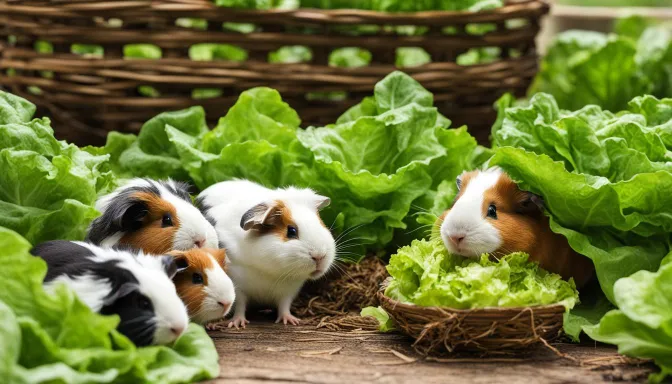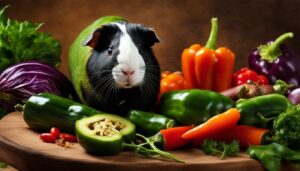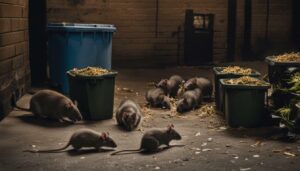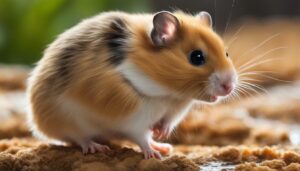Are you wondering if your furry friend can enjoy a crisp and refreshing lettuce treat? Well, we have the answer for you!
Guinea pigs can indeed eat lettuce, but it’s important to understand which types are safe and how to incorporate them into their diet. Let’s dive in and explore the wonderful world of lettuce for guinea pigs!
Key Takeaways:
- Guinea pigs can eat lettuce as part of their diet, but not all types are recommended.
- Romaine, green leaf, and red leaf lettuces are the best options for guinea pigs.
- Lettuce should be fed in moderation and accompanied by other fruits and vegetables.
- Overconsumption of lettuce, especially high-calcium types, can increase the risk of bladder stones.
- Offer a variety of vegetables and ensure a balanced diet with grass hay, pellets, and vitamin C supplements.
The Benefits of Lettuce for Guinea Pigs
Lettuce can be a valuable addition to a guinea pig’s diet, offering several benefits to their overall health and well-being. Here are some key reasons why lettuce is beneficial for guinea pigs:
- Nutrient-rich: Lettuce contains high levels of vitamin C, an essential nutrient for guinea pigs. This vitamin helps maintain their immune system and supports overall health. Additionally, lettuce provides other essential vitamins and minerals that contribute to a balanced diet.
- Hydration: Lettuce is a hydrating food for guinea pigs, especially during hot weather. The high water content in lettuce helps keep them properly hydrated and aids in digestion.
- Variety: Adding lettuce to a guinea pig’s diet provides them with a variety of textures and flavors. This can help prevent boredom and encourage healthy eating habits.
However, it’s important to note that while lettuce is beneficial, it should be fed in moderation. Too much lettuce can lead to digestive issues and an imbalance in their diet. It’s recommended to offer lettuce as part of a diverse range of vegetables and ensure that it makes up a small portion of their overall food intake.
| Lettuce Type | Frequency of Feeding |
|---|---|
| Romaine lettuce | 5-7 times per week |
| Green leaf lettuce | 5-7 times per week |
| Red leaf lettuce | 2-4 times per week |
| Butterhead lettuce | Moderation (2-4 times per week) |
Conclusion
Lettuce can provide valuable nutrients and hydration for guinea pigs. When incorporated into their diet in moderation, lettuce can contribute to their overall health and well-being. Remember to offer a variety of vegetables to ensure a balanced diet and monitor your guinea pig’s health and digestion.
Types of Lettuce for Guinea Pigs
When it comes to feeding lettuce to your guinea pig, not all types are created equal. Some varieties have higher nutrient content than others, making them better choices for your furry friend. Here are the best types of lettuce for guinea pigs:
Romaine Lettuce
Romaine lettuce is an excellent choice for guinea pigs. It is packed with essential nutrients like vitamin C and fiber, which are vital for their overall health. Romaine lettuce has a crisp texture and a slightly sweet taste, making it an appealing option for your pet.
Green Leaf Lettuce
Green leaf lettuce is another great option for guinea pigs. It contains high levels of vitamin A, which is essential for their eye health. Green leaf lettuce has a mild flavor and a tender texture, making it easily digestible for your furry friend.
Red Leaf Lettuce
Red leaf lettuce is a colorful and nutritious choice for guinea pigs. It is rich in antioxidants and provides a variety of vitamins and minerals. Red leaf lettuce has a slightly bitter taste, which can add some variety to your guinea pig’s diet.
When feeding these lettuces to your guinea pig, make sure to wash them thoroughly and remove any wilted or damaged leaves. Offer the lettuce in small, bite-sized pieces to prevent choking. Remember to introduce new foods gradually to avoid digestive upset.
| Lettuce Type | Nutrient Content | Flavor | Texture |
|---|---|---|---|
| Romaine Lettuce | High in vitamin C and fiber | Slightly sweet | Crisp |
| Green Leaf Lettuce | Rich in vitamin A | Mild | Tender |
| Red Leaf Lettuce | Antioxidant-rich | Slightly bitter | Crunchy |
By including these lettuce varieties in your guinea pig’s diet, you can provide them with a range of nutrients and flavors. Remember to always consult with a veterinarian for specific dietary recommendations for your guinea pig.
Feeding Guidelines for Lettuce
When it comes to feeding lettuce to your guinea pig, it’s important to follow some guidelines to ensure their health and well-being. Lettuce can be a nutritious addition to their diet, but it should be offered in moderation and alongside other fruits and vegetables.
Types of Lettuce and Frequency
Not all types of lettuce are created equal when it comes to their nutritional content for guinea pigs. Romaine lettuce and green leaf lettuce are considered the best options, as they have higher nutrient levels compared to iceberg lettuce. These types of lettuce can be fed to guinea pigs five to seven times a week. On the other hand, red leaf lettuce and butterhead lettuce should be limited to two to four times a week.
Table: Lettuce Feeding Guidelines
| Type of Lettuce | Feeding Frequency |
|---|---|
| Romaine Lettuce | 5-7 times a week |
| Green Leaf Lettuce | 5-7 times a week |
| Red Leaf Lettuce | 2-4 times a week |
| Butterhead Lettuce | 2-4 times a week |
Portion Size and Monitoring
Each feeding of lettuce should consist of one medium-sized leaf. It’s important not to overfeed lettuce to your guinea pig, as it can lead to health issues. Overconsumption of lettuce, especially varieties with high calcium content, can increase the risk of bladder stones. Keep an eye on your guinea pig’s urine for any signs of overconsumption or calcium deposits, and consult a veterinarian if you notice any abnormalities.
Remember that lettuce should not be the sole source of nutrition for your guinea pig. It should be offered alongside a balanced diet that includes hay, pellets, and a variety of other vegetables. Providing a diverse range of food ensures that your guinea pig receives all the necessary nutrients for optimal health.
By following these feeding guidelines, you can ensure that your guinea pig enjoys the benefits of lettuce while maintaining a healthy and balanced diet.
The Downsides of Lettuce for Guinea Pigs
While lettuce can be a healthy addition to a guinea pig’s diet, there are some downsides to consider. Overconsumption of lettuce, especially types with high calcium content, can increase the risk of bladder stones in guinea pigs. It’s important to monitor your guinea pig’s diet and make sure they are not consuming too much lettuce to prevent any health issues.
Iceberg lettuce, in particular, should be avoided as it has low nutritional value. This type of lettuce lacks the essential vitamins and nutrients that guinea pigs need to thrive. It’s best to opt for varieties like romaine, green leaf, and red leaf lettuces, which have higher nutrient content and are safer for your pet.
To ensure a balanced diet for your guinea pig, remember to offer a variety of vegetables along with lettuce. This will help provide a range of nutrients and prevent them from relying solely on lettuce for their nutritional needs. Monitor your guinea pig’s health and consult with a veterinarian if you notice any signs of overconsumption or health issues related to their diet.
Potential Downsides of Lettuce for Guinea Pigs:
- Increased risk of bladder stones due to overconsumption
- Low nutritional value in iceberg lettuce
| Lettuce Type | Nutrient Content | Feeding Frequency |
|---|---|---|
| Romaine | High | 5-7 times a week |
| Green Leaf | High | 5-7 times a week |
| Red Leaf | High | 2-4 times a week |
| Iceberg | Low | Avoid |
Guinea Pigs’ Preference for Lettuce
Guinea pigs have a natural affinity for lettuce and often choose it as their preferred vegetable. The crispy texture and mild flavor of lettuce make it a favorite food for many guinea pigs. When presented with a variety of vegetables, it’s common for them to devour the lettuce first before moving on to other options. This preference for lettuce can be attributed to their instinctual need for hydration and their enjoyment of the refreshing crunch.
Feeding lettuce to your guinea pig not only satisfies their taste preferences but also contributes to a well-rounded diet. Lettuce is a good source of vitamins and nutrients that are beneficial for their overall health. However, it’s important to remember that lettuce should be offered alongside a variety of other vegetables to ensure your guinea pig receives a balanced nutritional intake.
While guinea pigs enjoy lettuce, it’s essential to offer them other vegetables as well. A diverse selection of vegetables provides a range of nutrients and prevents boredom in their diet. Guinea pigs thrive on the nutritional variety, so it’s recommended to rotate different vegetables regularly to keep them happy and healthy. As with any food, it’s crucial to introduce new vegetables slowly and monitor your guinea pig’s digestion for any signs of upset.
Table: Recommended Vegetables for Guinea Pigs
| Vegetable | Frequency of Feeding |
|---|---|
| Romaine Lettuce | 5-7 times a week |
| Green Leaf Lettuce | 5-7 times a week |
| Red Leaf Lettuce | 2-4 times a week |
| Butterhead Lettuce | Moderation (2-4 times a week) |
| Parsley | Moderation (2-3 times a week) |
| Cilantro | Moderation (2-3 times a week) |
| Carrots | 2-3 times a week |
| Tomatoes | 2-3 times a week |
| Dandelion Greens | Moderation (2-3 times a week) |
Other Vegetables for Guinea Pigs
In addition to lettuce, there are many other vegetables that can be included in a guinea pig’s diet. These vegetables provide a variety of nutrients and flavors, ensuring a well-rounded and nutritious meal for your furry friend. Here are some safe and healthy options:
Parsley
Parsley is rich in vitamin C and other essential nutrients. It can be served in small quantities as an occasional treat, as it has a strong flavor that some guinea pigs may find overpowering.
Cilantro
Similar to parsley, cilantro is a good source of vitamin C and adds a refreshing taste to your guinea pig’s diet. It can be served in moderation, as some guinea pigs may not enjoy the strong flavor.
Carrots
Carrots are a favorite among guinea pigs. They are rich in vitamin A and provide a satisfying crunch. Be sure to cut carrots into small, bite-sized pieces to prevent choking.
Tomatoes
Tomatoes contain vitamin C and lycopene, which can have various health benefits for guinea pigs. However, they should be given in small quantities due to their high acidity.
Dandelion Greens
Dandelion greens are safe and nutritious for guinea pigs. They are packed with vitamins and minerals and can be a welcome addition to your guinea pig’s diet.
Remember, when introducing new vegetables to your guinea pig, it’s important to do so gradually. Start with small amounts and observe their reaction. If there are any signs of digestive upset, discontinue feeding that particular vegetable. Always provide fresh, clean vegetables and remove any uneaten portions to maintain hygiene. With a diverse selection of vegetables, you can ensure that your guinea pig enjoys a varied and healthy diet.
| Veggies | Nutritional Benefits |
|---|---|
| Parsley | High in vitamin C |
| Cilantro | Good source of vitamin C |
| Carrots | Rich in vitamin A |
| Tomatoes | Contain vitamin C and lycopene |
| Dandelion Greens | Packed with vitamins and minerals |
The Importance of Grass Hay in a Guinea Pig’s Diet
Grass hay plays a crucial role in a guinea pig’s diet, providing essential fiber and helping to maintain their dental health. It should make up about 75% of their daily food intake. Guinea pigs have unique digestive systems that require a high-fiber diet to support proper digestion and prevent gastrointestinal issues. Grass hay, such as Timothy or orchard grass, is an excellent choice as it is low in calories and high in fiber, promoting healthy digestion and preventing obesity.
In addition to its digestive benefits, grass hay also helps wear down a guinea pig’s continuously growing teeth. The constant chewing action required to consume hay helps prevent overgrowth and dental problems, ensuring their teeth remain healthy and properly aligned. Providing unlimited access to high-quality grass hay is essential for their overall well-being.
The Benefits of Grass Hay
Aside from its digestive and dental benefits, grass hay also provides mental stimulation for guinea pigs. They enjoy foraging and nibbling, which hay allows them to do. It helps to satisfy their natural instinct to graze and keeps them entertained, preventing boredom-induced behaviors. Additionally, the long strands of grass hay encourage proper gut motility, reducing the risk of gastrointestinal stasis and related health issues.
| Benefits of Grass Hay | |
|---|---|
| Promotes healthy digestion | Prevents obesity |
| Aids in dental health | Provides mental stimulation |
| Supports gut motility | Prevents boredom-induced behaviors |
Overall, grass hay is a vital component of a guinea pig’s diet. It provides the necessary fiber, aids in dental health, and promotes proper digestion. As responsible guinea pig owners, it’s our duty to ensure that our furry friends have unlimited access to high-quality grass hay to meet their nutritional and behavioral needs.
Supplementary Pellets and Vitamin C
Supplementary pellets can be a valuable addition to a guinea pig’s diet. They provide essential nutrients that may be lacking in other foods. When selecting pellets for your guinea pig, it’s important to choose a brand that is specifically formulated for guinea pigs, such as Oxbow.
Guinea pig pellets should not contain any seeds, nuts, or dried fruits, as these can be harmful to their health. It’s best to opt for pellets that are made with high-quality ingredients and do not contain any artificial additives or preservatives.
Vitamin C is vital for the health of guinea pigs, as they are unable to produce it on their own. It’s crucial to provide them with a sufficient amount of vitamin C in their diet to prevent deficiencies. This can be achieved by offering vitamin C-rich vegetables or providing a vitamin C supplement in tablet form, specifically made for guinea pigs.
Summary
- Supplementary pellets can provide important nutrients for guinea pigs.
- Choose guinea pig-specific pellets without seeds, nuts, or dried fruits.
- Vitamin C is crucial for guinea pigs’ health and can be provided through vegetables or supplements.
| Supplementary Pellets and Vitamin C | |
|---|---|
| Key Points |
|
Fruit and Treats for Guinea Pigs
When it comes to treating your guinea pig, it’s important to choose fruits and treats wisely. While fruits can provide a sweet and tasty addition to their diet, they should be given sparingly due to their high sugar content. Here are some fruits that are safe for guinea pigs to enjoy occasionally:
- Apples: Remove the seeds and core, and slice into small pieces.
- Pineapples: Cut into small chunks and remove the skin.
- Berries: Offer strawberries, raspberries, or blueberries in small portions.
- Cantaloupes: Remove the seeds and rind, and slice into bite-sized pieces.
Remember to introduce new fruits slowly and monitor your guinea pig for any signs of digestive upset. Fruits should only make up a small percentage of their overall diet, ideally no more than 5%.
In addition to fruits, it’s important to provide your guinea pig with healthy treats that are specifically made for them. Look for treats that are low in sugar and fat, and avoid those that contain artificial ingredients. Treats should be given in moderation, as they are not a substitute for a balanced diet. Always read the labels and choose treats that are safe and nutritious for your furry friend.
| Treat | Description |
|---|---|
| Oxbow Simple Rewards | A variety of flavors made with natural ingredients. |
| Kaytee Timothy Biscuits | Crispy treats made with Timothy hay for added fiber. |
| Small Pet Select Herbal Blends | Dried herb mixes that provide flavor and enrichment. |
Remember, treats should not comprise a significant portion of your guinea pig’s daily food intake. Always prioritize their main diet of hay, vegetables, and pellets to ensure their nutritional needs are met. By offering a balanced and varied diet, along with the occasional treat, you can keep your guinea pig happy and healthy.
Foods to Avoid and Foods to Give in Moderation
When it comes to feeding your guinea pig, it’s important to be aware of the foods that should be avoided or given in moderation. Certain foods can cause digestive issues, urinary stone formation, and other health problems in guinea pigs. Here are some guidelines to follow:
Foods to Avoid:
- Nuts and seeds: Guinea pigs have sensitive digestive systems and cannot properly digest nuts and seeds. These foods can lead to digestive upset and potential blockages.
- Dried fruits: Dried fruits are high in sugar and can cause weight gain and dental issues in guinea pigs. Stick to fresh fruits in limited quantities as treats.
- Meat products: Guinea pigs are herbivores and should not be fed any meat products. Their digestive systems are not equipped to handle animal protein.
- High-starch foods: Foods like bread, pasta, and potatoes are high in starch and can lead to digestive problems in guinea pigs. Stick to a diet primarily composed of hay, vegetables, and limited pellets.
Foods to Give in Moderation:
- Cruciferous vegetables: Vegetables like cabbage and broccoli, while nutritious, can cause gas and digestive issues in guinea pigs if fed in excess. Offer these vegetables in small amounts and monitor your guinea pig’s digestion.
- High oxalate greens: Greens like kale and spinach are high in oxalates, which can contribute to urinary stone formation. Feed these greens in moderation to prevent health problems.
When choosing commercial treats for your guinea pig, be cautious of excess sugar and fat content. These treats should only make up a small percentage of your guinea pig’s overall diet. Opt for healthy and natural treats, such as small pieces of fresh fruits or specially made guinea pig treats.
| Foods to Avoid | Foods to Give in Moderation |
|---|---|
| Nuts and seeds | Cruciferous vegetables |
| Dried fruits | High oxalate greens |
| Meat products | |
| High-starch foods |
Conclusion
In conclusion, guinea pigs can indeed eat lettuce as part of their diet. However, it is important to choose the right type of lettuce and feed it to them in moderation to ensure their nutritional needs are met. Lettuce provides various vitamins and nutrients, especially vitamin C, which is essential for their health and immunity. It can also serve as a hydrating option for them.
Remember that not all types of lettuce are suitable for guinea pigs. Romaine, green leaf, and red leaf lettuces are considered the best options due to their higher nutrient content. It is recommended to feed these lettuces multiple times a week. On the other hand, iceberg lettuce should be avoided as it lacks significant nutritional value.
Along with lettuce, it is important to offer a variety of other vegetables, such as parsley, cilantro, carrots, tomatoes, and dandelion greens, to provide a balanced diet for your guinea pig. Grass hay, specifically Timothy or orchard grass, should make up about 75% of their daily food intake to maintain their dental health and aid in digestion.
Supplementary pellets, vitamin C supplements, and occasional fruits can also be included in their diet. However, it is crucial to avoid overfeeding and to select treats and pellets without excessive sugar, fat, seeds, or dried fruits. By providing a well-rounded diet and monitoring their overall health, you can ensure the well-being and happiness of your furry friend.
FAQ
Can guinea pigs eat lettuce?
Yes, guinea pigs can eat lettuce as part of their diet.
What types of lettuce are recommended for guinea pigs?
Romaine, green leaf, and red leaf lettuces are considered the best options for guinea pigs.
How often can guinea pigs eat lettuce?
Romaine and green leaf lettuces can be fed to guinea pigs five to seven times a week, while red leaf and butterhead lettuces should be limited to two to four times a week.
Why is lettuce beneficial for guinea pigs?
Lettuce is a good source of vitamins and nutrients, including vitamin C, calcium, and hydration.
What should I watch out for when feeding lettuce to guinea pigs?
You should monitor your guinea pig’s urine for signs of overconsumption or calcium deposits.
Can guinea pigs eat other vegetables?
Yes, guinea pigs can eat a variety of other vegetables, including parsley, cilantro, carrots, tomatoes, and dandelion greens.
How important is grass hay in a guinea pig’s diet?
Grass hay, such as Timothy or orchard grass, is crucial for a guinea pig’s dental health and digestion. It should make up about 75% of their daily food intake.
What are suitable treats for guinea pigs?
Fruits like apples, pineapples, berries, and cantaloupes can be offered occasionally as treats. Treats should be limited to 0-5% of their diet.
Are there any foods that guinea pigs should avoid?
Guinea pigs should avoid nuts, seeds, dried fruits, meat products, high-starch foods, and certain vegetables like cabbage and kale in excess.
Can guinea pigs produce vitamin C on their own?
No, guinea pigs cannot produce vitamin C on their own. They require vitamin C supplements or vitamin C-rich vegetables in their diet.




